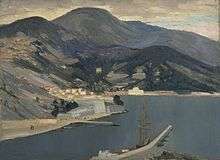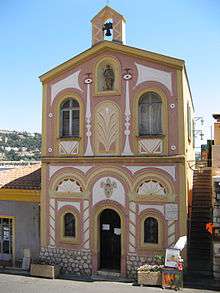Villefranche-sur-Mer
| Villefranche-sur-Mer | ||
|---|---|---|
|
A view of the harbour at Villefranche-sur-Mer | ||
| ||
 Villefranche-sur-Mer | ||
|
Location within Provence-A.-C.d'A. region  Villefranche-sur-Mer | ||
| Coordinates: 43°42′18″N 7°18′45″E / 43.705°N 7.3125°ECoordinates: 43°42′18″N 7°18′45″E / 43.705°N 7.3125°E | ||
| Country | France | |
| Region | Provence-Alpes-Côte d'Azur | |
| Department | Alpes-Maritimes | |
| Arrondissement | Nice | |
| Canton | Villefranche-sur-Mer | |
| Intercommunality | Nice-Côte d'Azur | |
| Government | ||
| • Mayor (2008–2014) | Gérard Grosgogeat | |
| Area1 | 4.88 km2 (1.88 sq mi) | |
| Population (2010)2 | 5,471 | |
| • Density | 1,100/km2 (2,900/sq mi) | |
| INSEE/Postal code | 06159 / 06230 | |
| Elevation | 0–575 m (0–1,886 ft) | |
|
1 French Land Register data, which excludes lakes, ponds, glaciers > 1 km² (0.386 sq mi or 247 acres) and river estuaries. 2 Population without double counting: residents of multiple communes (e.g., students and military personnel) only counted once. | ||
Villefranche-sur-Mer (French: [vilfʁɑ̃ʃ syʁ mɛːʁ]; Niçard: Vilafranca de Mar, Italian: Villafranca Marittima, pronounced [vilːaˈfraŋka maˈritːima]) is a commune in the Alpes-Maritimes department in the Provence-Alpes-Côte d'Azur region on the French Riviera.
Geography
Villefranche-sur-Mer adjoins the city of Nice to the east along Mont Boron, Mont Alban and Mont Vinaigrier, and 10 km (6.2 mi) south west of Monaco. The bay (rade) of Villefranche is one of the deepest natural harbours of any port in the Mediterranean Sea and provides safe anchorage for large ships, reaching depths of 95 m (320 ft) between the Cape of Nice and Cap Ferrat; it extends to the south to form a 500 m (1700 ft) abyss known as the undersea Canyon of Villefranche at about one nautical mile off the coastline.
The town limits extend to the hills surrounding the bay climbing from sea level to an altitude of 520 m (1750 ft) at Mont-Leuze, reflecting on land the features found offshore. The three "Corniches" or main roads linking Nice to Italy pass through Villefranche.
History

The site of what is now Villefranche and surrounding Beaulieu-sur-Mer and Saint-Jean-Cap-Ferrat has been settled since prehistoric times. Celto-ligurian tribes roamed the area and established farming communities on the surrounding hills. The Greeks and later the Romans used the natural harbour as a stop-over en route to the Greek settlements around the Western Mediterranean. After the conquest of Gaul by Julius Caesar, the Romans built an extension of the Via Aurelia (Aurelian Way), which passed through the settlement of Montolivo.
By the fall of the Carolingian Empire, the area was part of Lotharingia and later part of the County of Provence. In 1295, Charles II, Duke of Anjou, then Count of Provence, enticed the inhabitants of Montolivo and surroundings to settle closer to the coastline in order to secure the area from pirates. By charter, he established Villefranche as a "free port", thus the name, granting tax privileges and port fee rights that lasted well into the 18th century.[1]


by Louis Dewis
By 1388, East Provence became part of the Duchy of Savoy as a result of the disputed succession to the heirless Queen Joan I of Naples. For the next 400 years, the area known as the County of Nice was hotly disputed between the Holy Roman Empire to which Savoy was an ally and the French.
In 1543, the Franco-Turkish armies sacked and occupied the city after the siege of Nice, prompting Duke Emmanuel Philibert to secure the site by building an impressive citadel and a fort on nearby Mont Alban. In the late 17th century, the area fell to the French but was returned to Savoy after the Peace of Utrecht.[2]
During the 18th century, the city lost some of its maritime importance to the new harbour being built in Nice but remained a military and naval base. In 1744, a Franco-Spanish army under the Prince of Conti overran the Piedmontese regiments of Charles Emmanuel III of Sardinia at the Fort of Mont Alban in the heights above the town.
In 1793, the French returned to re-occupy Villefranche and the county of Nice remained part of the Napoleonic Empire until 1814. It was returned to the Kingdom of Sardinia by the Congress of Vienna.
In 1860, as a consequence of the Risorgimento, it was given to France by treaty following a plebiscite.
By the late 19th century it had become an important Russian Navy base and the Russians established an oceanographic laboratory in the old lazaret.[2]
The site was also the winter residence for royalties and wealthy visitors.
Villefranche's bay is notable for reaching a significant depth only a short distance from shore. As a result it has become an important port over the years. Since World War I, the United States Navy has called on a regular basis, making Villefranche the home port of the U.S. 6th Fleet from 1948 to February, 1966, when French President Charles DeGaulle withdrew France from NATO and required U.S. forces to leave. During the most recent years before 1966 the flagship of the Commander Sixth Fleet rotated between USS Springfield (CLG 7) and USS Little Rock (CLG 4).[3] Since the 1980s Villefranche has been used by cruise ships. It is the most visited cruise ship port of call in France.[2]
Population
| Historical population | ||
|---|---|---|
| Year | Pop. | ±% |
| 1962 | 5,953 | — |
| 1968 | 6,790 | +14.1% |
| 1975 | 7,200 | +6.0% |
| 1982 | 7,363 | +2.3% |
| 1990 | 8,080 | +9.7% |
| 1999 | 6,833 | −15.4% |
| 2008 | 6,244 | −8.6% |
| 2010 | 5,471 | −12.4% |
Villefranche is now part of the Urban community of Nice Côte d'Azur and so can be considered a suburb of the Nice metropolitan area. The decrease in population in recent years and especially in the 1990s can be attributed to the cost of real estate and an increase of part-time residents, who typically are not counted in the census. But Villefranche's aging population, like elsewhere in the eastern part of the Alpes-Maritimes, is not being replaced by younger people at the same rate as in the rest of the département.[4]
Economy
The main activity remains tourism, with hotels and restaurants employing a sizeable portion of the population. Traditional activities, like fishing, have now given way to sea-related activities, such as sailing and deep sea diving. Some dockyard activity remains at the harbour of “la Darse” but most of it has now been moved to Antibes. Residential construction and maintenance, which provided a lot of employment in the mid 20th century, has now subsided considerably.
Places of interest
Churches and chapels

- Église Saint-Michel (Saint Michael's Church) in the heart of old town, was built in the 1750s in the baroque Italian-style where originally stood a more modest early fourteenth century church. It houses various works of art, notably a large Saint Michael painting above the marble main altar, a recumbent sculpture Christ (18th century) known as the "Christ of the Galleys" and a polychrome wooden statue of San Rocco. The organ built by the Grinda Brothers in 1790 is one of the oldest of the County of Nice still in operation. The building was included in the French Historic Sites Registry in 1990.[5]
- The Chapelle Saint-Pierre (Saint Peter's Chapel) dates from the sixteenth century. Used as a storeroom for local fishermen's nets and equipment for most of the 19th and early part of the 20th century, it was restored in 1957 with Jean Cocteau adding his now-famous murals depicting the life of the saint and of local fishermen. The building was included in the French Historic Sites Registry in 1995.[5]
Other public buildings
- The old harbour of la Darse dates back to the 17th century. Built originally for the galleys of the Duke of Savoy, it is now a marina with dockyard activities for yachts. It is also the site of the oceanographic observatory Observatoire Oceanologique de Villefranche[6] of the Pierre and Marie Curie University of Paris and of the French National Centre for Scientific Research with 3 laboratories (oceanology, marine geoscience and cell biology) and 150 personnels attached to it.[7] Buildings and structures surrounding the harbour are also included in the French Historic Sites Registry since 1991.[5]
- The Citadel built in 1557 now houses the Town Hall, a convention centre, three museums and an open-air theatre.[5]
- The Rue Obscure or “Dark Street” is a passageway under the harbour front houses which dates back to 1260.
- The Villa Léopolda on the hills surrounding was once the residence of King Leopold II of Belgium and has been tagged as “the most expensive house in the world”..
Gallery
-
_p067_VILLA_FRANCA_HARBOUR.jpg)
The Harbour in 1870
-
View on the old harbour of Darse de Villefranche-sur-Mer
-
View on the Observatoire Oceanologique de Villefranche
-
Entrance to the "RVE OBSCVRE" (the Rue Obscure
-
The Villa Léopolda
-

A view down a street
Public beaches
- Plage des Marinières is the main beach and is located at the north end of the bay. It stretches for 1 km under the track of the railway line linking Nice to Italy.
- Plage de la Darse is a smaller pebble beach located behind the main jetty of the harbour of La Darse.
Media
The old town and the bay have offered for years a natural set for movie makers. Among many productions to name just a few:
- Raoul Walsh’s Captain Horatio Hornblower R.N.
- Adventures of Captain Fabian with Errol Flynn
- Alfred Hitchcock’s To Catch a Thief
- The Count of Monte Cristo with Louis Jourdan
- Leo McCarey's An Affair to Remember
- The Madwoman of Chaillot with Katharine Hepburn
- Never Say Never Again with Sean Connery
- The Jewel of the Nile with Michael Douglas
- The Bourne Identity with Richard Chamberlain
- Killers with Ashton Kutcher,
- Maximum Risk with Jean-Claude Van Damme
- Dirty Rotten Scoundrels with Steve Martin and Michael Caine
- Ronin with Robert De Niro
Villefranche-sur-Mer is also a harbour for visiting naval forces and particularly US Navy ships. (for example the USS Barry (DD-933) and the USS Volador (SS-490))
The façades of the buildings in the harbour were the inspiration for the film set in the Moteurs... Action! Stunt Show Spectacular at the Walt Disney Studios Park in Disneyland Paris and Disney's Hollywood Studios in Walt Disney World, Florida.[8]
It was also at Villefranche-Sur-Mer that The Rolling Stones recorded their 1972 album Exile on Main St., at the Belle Epoque-era mansion Nellcôte.
Some scenes in Amy Plum's "Revenants" trilogy take place in Villefranche-sur-Mer.
Sister cities
- Bordighera,
 Italy
Italy - Cape Coral, Florida,
 United States
United States - Nieuwpoort,
.svg.png) Belgium
Belgium - Plan-les-Ouates,
 Switzerland
Switzerland - Reiskirchen,
 Germany
Germany
See also
- Communes of the Alpes-Maritimes department
- Russian Steam Navigation and Trading Company
- Villa Nellcôte
References
- ↑ (French) Barelli H. – Rocca R.:’’Histoire de l’Identité Niçoise’’, page 22-31, Serre Editeur 1998
- 1 2 3 (French) Tracou C.-Richard D.:’’La Rade Étincelante’’, page 11, 66 and 77, Éditions 2Fab 1995
- ↑ http://www.usslittlerock.org/Villefranche/villafrance.html
- ↑ "Territoires de SCOT en Provence Alpes Côte d’Azur" (PDF). www.insee.fr (in French).
- 1 2 3 4 "Mediathequede l’Architecture et du Patrimoine". Ministère de la Culture – Base Mérimée (in French).
- ↑ "L'Observatoire Oceanologique de Villefranche sur Mer". Retrieved 3 August 2009.
- ↑ "Site de l'observatoire océanologique" (in French).
- ↑ http://www.youtube.com/watch?v=aNEiJkkn-Vk
| Wikimedia Commons has media related to Villefranche-sur-Mer. |

